Splash是一个JavaScript渲染服务,是一个带有HTTP API的轻量级浏览器,同时它对接了Python中的Twisted和QT库。利用它,我们同样可以实现动态渲染页面的抓取。
1. 功能介绍
·利用Splash,我们可以实现如下功能:
·异步方式处理多个网页渲染过程;
·获取渲染后的页面的源代码或截图;
·通过关闭图片渲染或者使用Adblock规则来加快页面渲染速度;
·可执行特定的JavaScript脚本;
·可通过Lua脚本来控制页面渲染过程;
·获取渲染的详细过程并通过HAR(HTTP Archive)格式呈现。
接下来,我们来了解一下它的具体用法。
2. 准备工作
在开始之前,请确保已经正确安装好了Splash并可以正常运行服务。如果没有安装,可以参考第1章。
3. 实例引入
首先,通过Splash提供的Web页面来测试其渲染过程。例如,我们在本机8050端口上运行了Splash服务,打开http://localhost:8050/即可看到其Web页面,如图7-6所示。
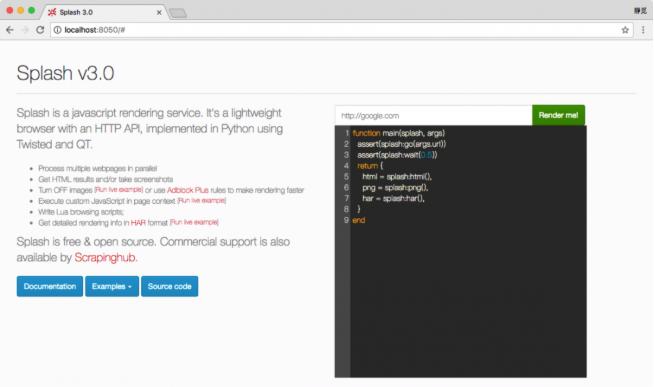
图7-6 Web页面
在图7-6右侧,呈现的是一个渲染示例。可以看到,上方有一个输入框,默认是http://google.com,这里换成百度测试一下,将内容更改为https://www.baidu.com,然后点击Render me按钮开始渲染,结果如图7-7所示。
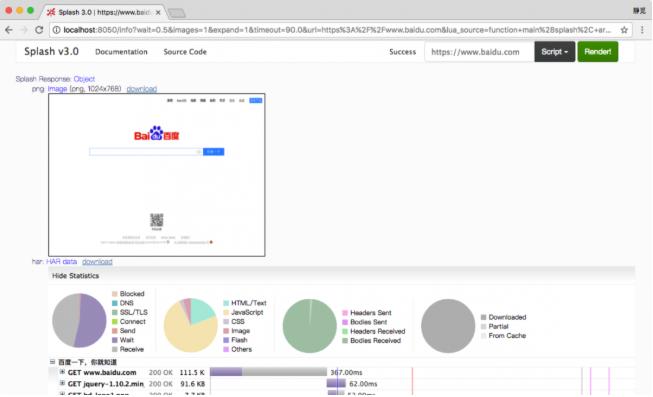
图7-7 运行结果
可以看到,网页的返回结果呈现了渲染截图、HAR加载统计数据、网页的源代码。
通过HAR的结果可以看到,Splash执行了整个网页的渲染过程,包括CSS、JavaScript的加载等过程,呈现的页面和我们在浏览器中得到的结果完全一致。
那么,这个过程由什么来控制呢?重新返回首页,可以看到实际上是有一段脚本,内容如下:
function main(splash, args) assert(splash:go(args.url)) assert(splash:wait(0.5)) return { html = splash:html(), png = splash:png(), har = splash:har(), } end这个脚本实际上是用Lua语言写的脚本。即使不懂这个语言的语法,但从脚本的表面意思,我们也可以大致了解到它首先调用go()方法去加载页面,然后调用wait()方法等待了一定时间,最后返回了页面的源码、截图和HAR信息。
到这里,我们大体了解了Splash是通过Lua脚本来控制了页面的加载过程的,加载过程完全模拟浏览器,最后可返回各种格式的结果,如网页源码和截图等。
接下来,我们就来了解Lua脚本的写法以及相关API的用法。
4. Splash Lua脚本
Splash可以通过Lua脚本执行一系列渲染操作,这样我们就可以用Splash来模拟类似Chrome、PhantomJS的操作了。
首先,我们来了解一下Splash Lua脚本的入口和执行方式。
入口及返回值
首先,来看一个基本实例:
function main(splash, args) splash:go("http://www.baidu.com") splash:wait(0.5) local title = splash:evaljs("document.title") return {title=title} end我们将代码粘贴到刚才打开的http://localhost:8050/的代码编辑区域,然后点击Render me!按钮来测试一下。
我们看到它返回了网页的标题,如图7-8所示。这里我们通过evaljs()方法传入JavaScript脚本,而document.title的执行结果就是返回网页标题,执行完毕后将其赋值给一个title变量,随后将其返回。
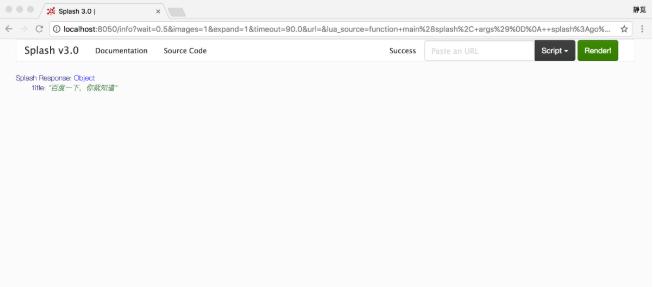
图7-8 运行结果
注意,我们在这里定义的方法名称叫作main()。这个名称必须是固定的,Splash会默认调用这个方法。
该方法的返回值既可以是字典形式,也可以是字符串形式,最后都会转化为Splash HTTP Response,例如:
function main(splash) return {hello="world!"} end返回了一个字典形式的内容。例如:
function main(splash) return 'hello' end返回了一个字符串形式的内容。
异步处理
Splash支持异步处理,但是这里并没有显式指明回调方法,其回调的跳转是在Splash内部完成的。示例如下:
function main(splash, args) local example_urls = {"www.baidu.com", "www.taobao.com", "www.zhihu.com"} local urls = args.urls or example_urls local results = {} for index, url in ipairs(urls) do local ok, reason = splash:go("http://" .. url) if ok then splash:wait(2) results[url] = splash:png() end end return results end运行结果是3个站点的截图,如图7-9所示。
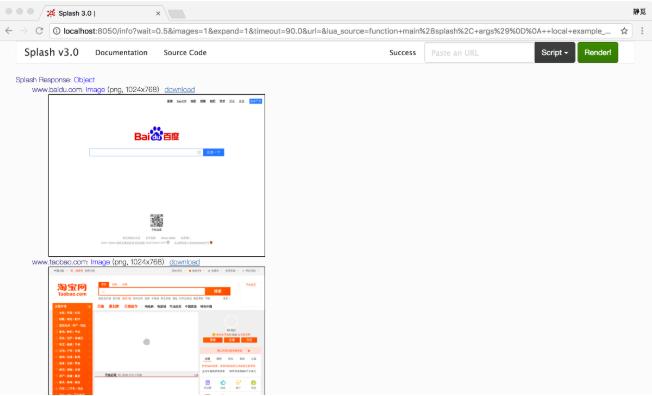
图7-9 运行结果
在脚本内调用的wait()方法类似于Python中的sleep(),其参数为等待的秒数。当Splash执行到此方法时,它会转而去处理其他任务,然后在指定的时间过后再回来继续处理。
这里值得注意的是,Lua脚本中的字符串拼接和Python不同,它使用的是..操作符,而不是+。如果有必要,可以简单了解一下Lua脚本的语法,详见http://www.runoob.com/lua/lua-basic-syntax.html。
另外,这里做了加载时的异常检测。go()方法会返回加载页面的结果状态,如果页面出现4xx或5xx状态码,ok变量就为空,就不会返回加载后的图片。
5. Splash对象属性
我们注意到,前面例子中main()方法的第一个参数是splash,这个对象非常重要,它类似于Selenium中的WebDriver对象,我们可以调用它的一些属性和方法来控制加载过程。接下来,先看下它的属性。
args
该属性可以获取加载时配置的参数,比如URL,如果为GET请求,它还可以获取GET请求参数;如果为POST请求,它可以获取表单提交的数据。Splash也支持使用第二个参数直接作为args,例如:
function main(splash, args) local url = args.url end这里第二个参数args就相当于splash.args属性,以上代码等价于:
function main(splash) local url = splash.args.url endjs_enabled
这个属性是Splash的JavaScript执行开关,可以将其配置为true或false来控制是否执行JavaScript代码,默认为true。例如,这里禁止执行JavaScript代码:
function main(splash, args) splash:go("https://www.baidu.com") splash.js_enabled = false local title = splash:evaljs("document.title") return {title=title} end接着我们重新调用了evaljs()方法执行JavaScript代码,此时运行结果就会抛出异常:
{ "error": 400, "type": "ScriptError", "info": { "type": "JS_ERROR", "js_error_message": null, "source": "[string \"function main(splash, args)\r...\"]", "message": "[string \"function main(splash, args)\r...\"]:4: unknown JS error: None", "line_number": 4, "error": "unknown JS error: None", "splash_method": "evaljs" }, "description": "Error happened while executing Lua script" }不过一般来说,不用设置此属性,默认开启即可。
resource_timeout
此属性可以设置加载的超时时间,单位是秒。如果设置为0或nil(类似Python中的None),代表不检测超时。示例如下:
function main(splash) splash.resource_timeout = 0.1 assert(splash:go('https://www.taobao.com')) return splash:png() end例如,这里将超时时间设置为0.1秒。如果在0.1秒之内没有得到响应,就会抛出异常,错误如下:
{ "error": 400, "type": "ScriptError", "info": { "error": "network5", "type": "LUA_ERROR", "line_number": 3, "source": "[string \"function main(splash)\r...\"]", "message": "Lua error: [string \"function main(splash)\r...\"]:3: network5" }, "description": "Error happened while executing Lua script" }此属性适合在网页加载速度较慢的情况下设置。如果超过了某个时间无响应,则直接抛出异常并忽略即可。
images_enabled
此属性可以设置图片是否加载,默认情况下是加载的。禁用该属性后,可以节省网络流量并提高网页加载速度。但是需要注意的是,禁用图片加载可能会影响JavaScript渲染。因为禁用图片之后,它的外层DOM节点的高度会受影响,进而影响DOM节点的位置。因此,如果JavaScript对图片节点有操作的话,其执行就会受到影响。
另外值得注意的是,Splash使用了缓存。如果一开始加载出来了网页图片,然后禁用了图片加载,再重新加载页面,之前加载好的图片可能还会显示出来,这时直接重启Splash即可。
禁用图片加载的示例如下:
function main(splash, args) splash.images_enabled = false assert(splash:go('https://www.jd.com')) return {png=splash:png()} end这样返回的页面截图就不会带有任何图片,加载速度也会快很多。
plugins_enabled
此属性可以控制浏览器插件(如Flash插件)是否开启。默认情况下,此属性是false,表示不开启。可以使用如下代码控制其开启和关闭:
splash.plugins_enabled = true/falsescroll_position
通过设置此属性,我们可以控制页面上下或左右滚动。这是一个比较常用的属性,示例如下:
function main(splash, args) assert(splash:go('https://www.taobao.com')) splash.scroll_position = {y=400} return {png=splash:png()} end这样我们就可以控制页面向下滚动400像素值,结果如图7-10所示。
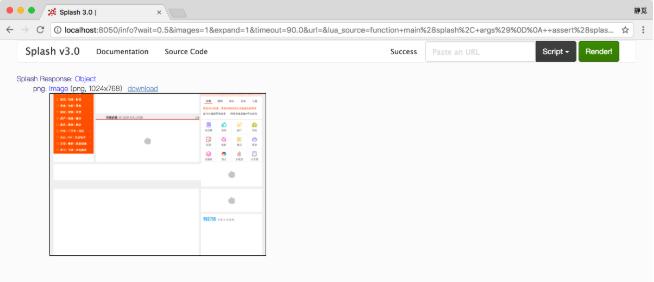
图7-10 运行结果
如果要让页面左右滚动,可以传入x参数,代码如下:
splash.scroll_position = {x=100, y=200}6. Splash对象的方法
除了前面介绍的属性外,Splash对象还有如下方法。
go()
该方法用来请求某个链接,而且它可以模拟GET和POST请求,同时支持传入请求头、表单等数据,其用法如下:
ok, reason = splash:go{url, baseurl=nil, headers=nil, http_method="GET", body=nil, formdata=nil}其参数说明如下。
url:请求的URL。
baseurl:可选参数,默认为空,表示资源加载相对路径。
headers:可选参数,默认为空,表示请求头。
http_method:可选参数,默认为GET,同时支持POST。
body:可选参数,默认为空,发POST请求时的表单数据,使用的Content-type为application/json。
formdata:可选参数,默认为空,POST的时候的表单数据,使用的Content-type为application/x-www-form-urlencoded。
该方法的返回结果是结果ok和原因reason的组合,如果ok为空,代表网页加载出现了错误,此时reason变量中包含了错误的原因,否则证明页面加载成功。示例如下:
function main(splash, args) local ok, reason = splash:go{"http://httpbin.org/post", http_method="POST", body="name=Germey"} if ok then return splash:html() end end这里我们模拟了一个POST请求,并传入了POST的表单数据,如果成功,则返回页面的源代码。
运行结果如下:
<html><head></head><body><pre style="word-wrap: break-word; white-space: pre-wrap;">{ "args": {}, "data": "", "files": {}, "form": { "name": "Germey" }, "headers": { "Accept": "text/html,application/xhtml+xml,application/xml;q=0.9,*/*;q=0.8", "Accept-Encoding": "gzip, deflate", "Accept-Language": "en,*", "Connection": "close", "Content-Length": "11", "Content-Type": "application/x-www-form-urlencoded", "Host": "httpbin.org", "Origin": "null", "User-Agent": "Mozilla/5.0 (X11; Linux x86_64) AppleWebKit/602.1 (KHTML, like Gecko) splash Version/9.0 Safari/602.1" }, "json": null, "origin": "60.207.237.85", "url": "http://httpbin.org/post" } </pre></body></html>可以看到,我们成功实现了POST请求并发送了表单数据。
wait()
此方法可以控制页面的等待时间,使用方法如下:
ok, reason = splash:wait{time, cancel_on_redirect=false, cancel_on_error=true}参数说明如下。
time:等待的秒数。
cancel_on_redirect:可选参数,默认为false,表示如果发生了重定向就停止等待,并返回重定向结果。
cancel_on_error:可选参数,默认为false,表示如果发生了加载错误,就停止等待。
返回结果同样是结果ok和原因reason的组合。
我们用一个实例感受一下:
function main(splash) splash:go("https://www.taobao.com") splash:wait(2) return {html=splash:html()} end这可以实现访问淘宝并等待2秒,随后返回页面源代码的功能。
jsfunc()
此方法可以直接调用JavaScript定义的方法,但是所调用的方法需要用双中括号包围,这相当于实现了JavaScript方法到Lua脚本的转换。示例如下:
function main(splash, args) local get_div_count = splash:jsfunc([[ function () { var body = document.body; var divs = body.getElementsByTagName('div'); return divs.length; } ]]) splash:go("https://www.baidu.com") return ("There are %s DIVs"):format( get_div_count()) end运行结果如下:
There are 21 DIVs首先,我们声明了一个JavaScript定义的方法,然后在页面加载成功后调用了此方法计算出了页面中div节点的个数。
关于JavaScript到Lua脚本的更多转换细节,可以参考官方文档:https://splash.readthedocs.io/en/stable/scripting-ref.html#splash-jsfunc。
evaljs()
此方法可以执行JavaScript代码并返回最后一条JavaScript语句的返回结果,使用方法如下:
result = splash:evaljs(js)比如,可以用下面的代码来获取页面标题:
local title = splash:evaljs("document.title")runjs()
此方法可以执行JavaScript代码,它与evaljs()的功能类似,但是更偏向于执行某些动作或声明某些方法。例如:
function main(splash, args) splash:go("https://www.baidu.com") splash:runjs("foo = function() { return 'bar' }") local result = splash:evaljs("foo()") return result end这里我们用runjs()先声明了一个JavaScript定义的方法,然后通过evaljs()来调用得到的结果。
运行结果如下:
barautoload()
此方法可以设置每个页面访问时自动加载的对象,使用方法如下:
ok, reason = splash:autoload{source_or_url, source=nil, url=nil}参数说明如下。
source_or_url:JavaScript代码或者JavaScript库链接。
source:JavaScript代码。
url:JavaScript库链接
但是此方法只负责加载JavaScript代码或库,不执行任何操作。如果要执行操作,可以调用evaljs()或runjs()方法。示例如下:
function main(splash, args) splash:autoload([[ function get_document_title(){ return document.title; } ]]) splash:go("https://www.baidu.com") return splash:evaljs("get_document_title()") end这里我们调用autoload()方法声明了一个JavaScript方法,然后通过evaljs()方法来执行此JavaScript方法。
运行结果如下:
百度一下,你就知道另外,我们也可以使用autoload()方法加载某些方法库,如jQuery,示例如下:
function main(splash, args) assert(splash:autoload("https://code.jquery.com/jquery-2.1.3.min.js")) assert(splash:go("https://www.taobao.com")) local version = splash:evaljs("$.fn.jquery") return 'JQuery version: ' .. version end运行结果如下:
JQuery version: 2.1.3call_later()
此方法可以通过设置定时任务和延迟时间来实现任务延时执行,并且可以在执行前通过cancel()方法重新执行定时任务。示例如下:
function main(splash, args) local snapshots = {} local timer = splash:call_later(function() snapshots["a"] = splash:png() splash:wait(1.0) snapshots["b"] = splash:png() end, 0.2) splash:go("https://www.taobao.com") splash:wait(3.0) return snapshots end这里我们设置了一个定时任务,0.2秒的时候获取网页截图,然后等待1秒,1.2秒时再次获取网页截图,访问的页面是淘宝,最后将截图结果返回。运行结果如图7-11所示。
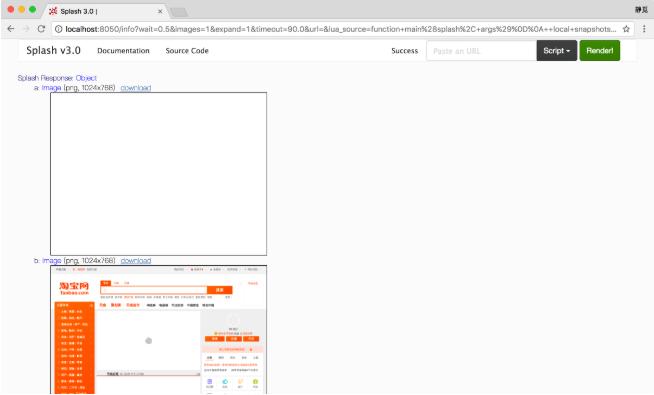
图7-11 运行结果
可以发现,第一次截图时网页还没有加载出来,截图为空,第二次网页便加载成功了。
http_get()
此方法可以模拟发送HTTP的GET请求,使用方法如下:
response = splash:http_get{url, headers=nil, follow_redirects=true}参数说明如下。
url:请求URL。
headers:可选参数,默认为空,请求头。
follow_redirects:可选参数,表示是否启动自动重定向,默认为true。
示例如下:
function main(splash, args) local treat = require("treat") local response = splash:http_get("http://httpbin.org/get") return { html=treat.as_string(response.body), url=response.url, status=response.status } end运行结果如下:
Splash Response: Object html: String (length 355) { "args": {}, "headers": { "Accept-Encoding": "gzip, deflate", "Accept-Language": "en,*", "Connection": "close", "Host": "httpbin.org", "User-Agent": "Mozilla/5.0 (X11; Linux x86_64) AppleWebKit/602.1 (KHTML, like Gecko) splash Version/9.0 Safari/602.1" }, "origin": "60.207.237.85", "url": "http://httpbin.org/get" } status: 200 url: "http://httpbin.org/get"和http_get()方法类似,此方法用来模拟发送POST请求,不过多了一个参数body,使用方法如下:
response = splash:http_post{url, headers=nil, follow_redirects=true, body=nil}参数说明如下。
url:请求URL。
headers:可选参数,默认为空,请求头。
follow_redirects:可选参数,表示是否启动自动重定向,默认为true。
body:可选参数,即表单数据,默认为空。
我们用实例感受一下:
function main(splash, args) local treat = require("treat") local json = require("json") local response = splash:http_post{"http://httpbin.org/post", body=json.encode({name="Germey"}), headers={["content-type"]="application/json"} } return { html=treat.as_string(response.body), url=response.url, status=response.status } end运行结果如下:
Splash Response: Object html: String (length 533) { "args": {}, "data": "{\"name\": \"Germey\"}", "files": {}, "form": {}, "headers": { "Accept-Encoding": "gzip, deflate", "Accept-Language": "en,*", "Connection": "close", "Content-Length": "18", "Content-Type": "application/json", "Host": "httpbin.org", "User-Agent": "Mozilla/5.0 (X11; Linux x86_64) AppleWebKit/602.1 (KHTML, like Gecko) splash Version/9.0 Safari/602.1" }, "json": { "name": "Germey" }, "origin": "60.207.237.85", "url": "http://httpbin.org/post" } status: 200 url: "http://httpbin.org/post"可以看到,这里我们成功模拟提交了POST请求并发送了表单数据。
set_content()
此方法用来设置页面的内容,示例如下:
function main(splash) assert(splash:set_content("<html><body><h1>hello</h1></body></html>")) return splash:png() end运行结果如图7-12所示。
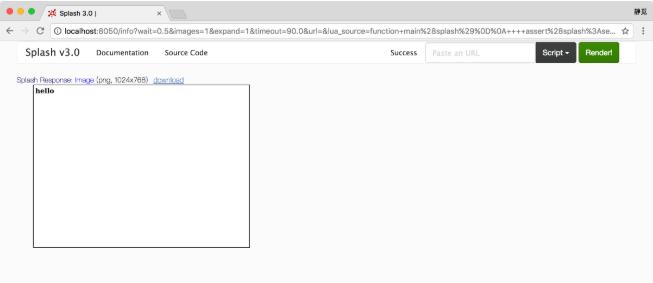
图7-12 运行结果
html()
此方法用来获取网页的源代码,它是非常简单又常用的方法。示例如下:
function main(splash, args) splash:go("https://httpbin.org/get") return splash:html() end运行结果如下:
<html><head></head><body><pre style="word-wrap: break-word; white-space: pre-wrap;">{ "args": {}, "headers": { "Accept": "text/html,application/xhtml+xml,application/xml;q=0.9,*/*;q=0.8", "Accept-Encoding": "gzip, deflate", "Accept-Language": "en,*", "Connection": "close", "Host": "httpbin.org", "User-Agent": "Mozilla/5.0 (X11; Linux x86_64) AppleWebKit/602.1 (KHTML, like Gecko) splash Version/9.0 Safari/602.1" }, "origin": "60.207.237.85", "url": "https://httpbin.org/get" } </pre></body></html>png()
此方法用来获取PNG格式的网页截图,示例如下:
function main(splash, args) splash:go("https://www.taobao.com") return splash:png() endjpeg()
此方法用来获取JPEG格式的网页截图,示例如下:
function main(splash, args) splash:go("https://www.taobao.com") return splash:jpeg() endhar()
此方法用来获取页面加载过程描述,示例如下:
function main(splash, args) splash:go("https://www.baidu.com") return splash:har() end运行结果如图7-13所示,其中显示了页面加载过程中每个请求记录的详情。
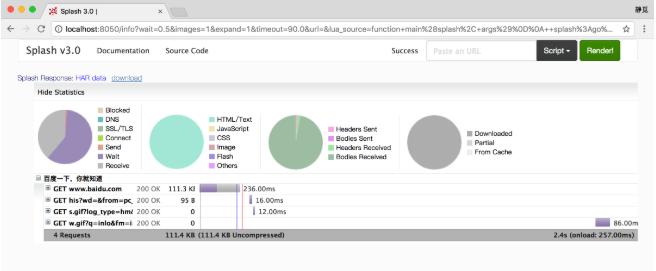
图7-13 运行结果
url()
此方法可以获取当前正在访问的URL,示例如下:
function main(splash, args) splash:go("https://www.baidu.com") return splash:url() end运行结果如下:
https://www.baidu.com/get_cookies()
此方法可以获取当前页面的Cookies,示例如下:
function main(splash, args) splash:go("https://www.baidu.com") return splash:get_cookies() end运行结果如下:
Splash Response: Array[2] 0: Object domain: ".baidu.com" expires: "2085-08-21T20:13:23Z" httpOnly: false name: "BAIDUID" path: "/" secure: false value: "C1263A470B02DEF45593B062451C9722:FG=1" 1: Object domain: ".baidu.com" expires: "2085-08-21T20:13:23Z" httpOnly: false name: "BIDUPSID" path: "/" secure: false value: "C1263A470B02DEF45593B062451C9722"此方法可以为当前页面添加Cookie,用法如下:
cookies = splash:add_cookie{name, value, path=nil, domain=nil, expires=nil, httpOnly=nil, secure=nil}该方法的各个参数代表Cookie的各个属性。
示例如下:
function main(splash) splash:add_cookie{"sessionid", "237465ghgfsd", "/", domain="http://example.com"} splash:go("http://example.com/") return splash:html() endclear_cookies()
此方法可以清除所有的Cookies,示例如下:
function main(splash) splash:go("https://www.baidu.com/") splash:clear_cookies() return splash:get_cookies() end这里我们清除了所有的Cookies,然后调用get_cookies()将结果返回。
运行结果如下:
Splash Response: Array[0]可以看到,Cookies被全部清空,没有任何结果。
get_viewport_size()
此方法可以获取当前浏览器页面的大小,即宽高,示例如下:
function main(splash) splash:go("https://www.baidu.com/") return splash:get_viewport_size() end运行结果如下:
Splash Response: Array[2] 0: 1024 1: 768set_viewport_size()
此方法可以设置当前浏览器页面的大小,即宽高,用法如下:
splash:set_viewport_size(width, height)例如,这里访问一个宽度自适应的页面:
function main(splash) splash:set_viewport_size(400, 700) assert(splash:go("http://cuiqingcai.com")) return splash:png() end运行结果如图7-14所示。
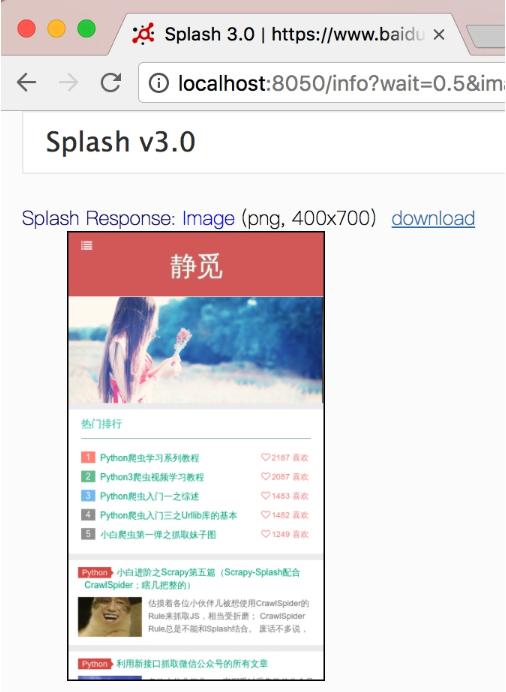
图7-14 运行结果
set_viewport_full()
此方法可以设置浏览器全屏显示,示例如下:
function main(splash) splash:set_viewport_full() assert(splash:go("http://cuiqingcai.com")) return splash:png() end此方法可以设置浏览器的User-Agent,示例如下:
function main(splash) splash:set_user_agent('Splash') splash:go("http://httpbin.org/get") return splash:html() end这里我们将浏览器的User-Agent设置为Splash,运行结果如下:
<html><head></head><body><pre style="word-wrap: break-word; white-space: pre-wrap;">{ "args": {}, "headers": { "Accept": "text/html,application/xhtml+xml,application/xml;q=0.9,*/*;q=0.8", "Accept-Encoding": "gzip, deflate", "Accept-Language": "en,*", "Connection": "close", "Host": "httpbin.org", "User-Agent": "Splash" }, "origin": "60.207.237.85", "url": "http://httpbin.org/get" } </pre></body></html>可以看到,此处User-Agent被成功设置。
set_custom_headers()
此方法可以设置请求头,示例如下:
function main(splash) splash:set_custom_headers({ ["User-Agent"] = "Splash", ["Site"] = "Splash", }) splash:go("http://httpbin.org/get") return splash:html() end这里我们设置了请求头中的User-Agent和Site属性,运行结果如下:
<html><head></head><body><pre style="word-wrap: break-word; white-space: pre-wrap;">{ "args": {}, "headers": { "Accept": "text/html,application/xhtml+xml,application/xml;q=0.9,*/*;q=0.8", "Accept-Encoding": "gzip, deflate", "Accept-Language": "en,*", "Connection": "close", "Host": "httpbin.org", "Site": "Splash", "User-Agent": "Splash" }, "origin": "60.207.237.85", "url": "http://httpbin.org/get" } </pre></body></html>该方法可以选中符合条件的第一个节点,如果有多个节点符合条件,则只会返回一个,其参数是CSS选择器。示例如下:
function main(splash) splash:go("https://www.baidu.com/") input = splash:select("#kw") input:send_text('Splash') splash:wait(3) return splash:png() end这里我们首先访问了百度,然后选中了搜索框,随后调用了send_text()方法填写了文本,然后返回网页截图。
结果如图7-15所示,可以看到,我们成功填写了输入框。
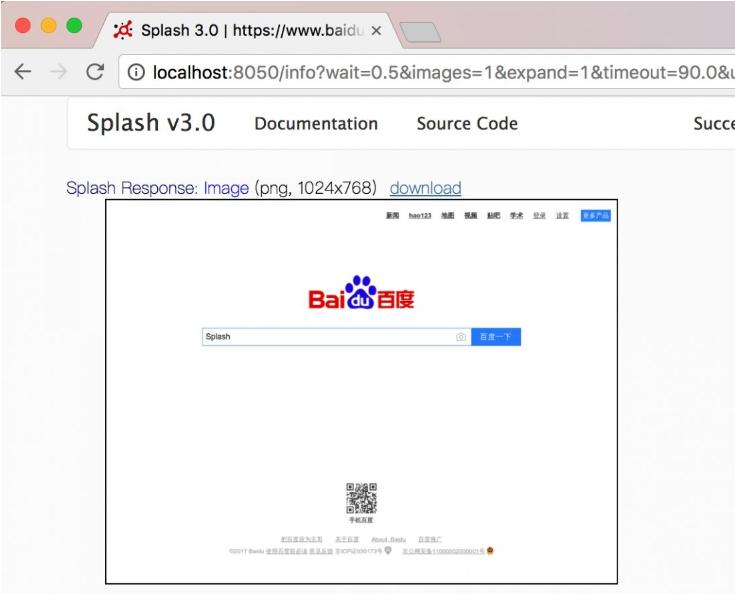
图7-15 运行结果
select_all()
此方法可以选中所有符合条件的节点,其参数是CSS选择器。示例如下:
function main(splash) local treat = require('treat') assert(splash:go("http://quotes.toscrape.com/")) assert(splash:wait(0.5)) local texts = splash:select_all('.quote .text') local results = {} for index, text in ipairs(texts) do results[index] = text.node.innerHTML end return treat.as_array(results) end这里我们通过CSS选择器选中了节点的正文内容,随后遍历了所有节点,将其中的文本获取下来。
运行结果如下:
Splash Response: Array[10] 0: "“The world as we have created it is a process of our thinking. It cannot be changed without changing our thinking.”" 1: "“It is our choices, Harry, that show what we truly are, far more than our abilities.”" 2: “There are only two ways to live your life. One is as though nothing is a miracle. The other is as though everything is a miracle.” 3: "“The person, be it gentleman or lady, who has not pleasure in a good novel, must be intolerably stupid.”" 4: "“Imperfection is beauty, madness is genius and it's better to be absolutely ridiculous than absolutely boring.”" 5: "“Try not to become a man of success. Rather become a man of value.”" 6: "“It is better to be hated for what you are than to be loved for what you are not.”" 7: "“I have not failed. I've just found 10,000 ways that won't work.”" 8: "“A woman is like a tea bag; you never know how strong it is until it's in hot water.”" 9: "“A day without sunshine is like, you know, night.”"可以发现,我们成功地将10个节点的正文内容获取了下来。
mouse_click()
此方法可以模拟鼠标点击操作,传入的参数为坐标值x和y。此外,也可以直接选中某个节点,然后调用此方法,示例如下:
function main(splash) splash:go("https://www.baidu.com/") input = splash:select("#kw") input:send_text('Splash') submit = splash:select('#su') submit:mouse_click() splash:wait(3) return splash:png() end这里我们首先选中页面的输入框,输入了文本,然后选中“提交”按钮,调用了mouse_click()方法提交查询,然后页面等待三秒,返回截图,结果如图7-16所示。

图7-16 运行结果
可以看到,这里我们成功获取了查询后的页面内容,模拟了百度搜索操作。
前面介绍了Splash的常用API操作,还有一些API在这不再一一介绍,更加详细和权威的说明可以参见官方文档https://splash.readthedocs.io/en/stable/scripting-ref.html,此页面介绍了Splash对象的所有API操作。另外,还有针对页面元素的API操作,链接为https://splash.readthedocs.io/en/stable/scripting-element-object.html。
7. Splash API调用
前面说明了Splash Lua脚本的用法,但这些脚本是在Splash页面中测试运行的,如何才能利用Splash渲染页面呢?怎样才能和Python程序结合使用并抓取JavaScript渲染的页面呢?
其实Splash给我们提供了一些HTTP API接口,我们只需要请求这些接口并传递相应的参数即可,下面简要介绍这些接口。
render.html
此接口用于获取JavaScript渲染的页面的HTML代码,接口地址就是Splash的运行地址加此接口名称,例如http://localhost:8050/render.html。可以用curl来测试一下:
curl http://localhost:8050/render.html?url=https://www.baidu.com我们给此接口传递了一个url参数来指定渲染的URL,返回结果即页面渲染后的源代码。
如果用Python实现的话,代码如下:
import requests url = 'http://localhost:8050/render.html?url=https://www.baidu.com' response = requests.get(url) print(response.text)这样就可以成功输出百度页面渲染后的源代码了。
另外,此接口还可以指定其他参数,比如通过wait指定等待秒数。如果要确保页面完全加载出来,可以增加等待时间,例如:
import requests url = 'http://localhost:8050/render.html?url=https://www.taobao.com&wait=5' response = requests.get(url) print(response.text)此时得到响应的时间就会相应变长,比如这里会等待5秒多钟才能获取淘宝页面的源代码。
另外,此接口还支持代理设置、图片加载设置、Headers设置、请求方法设置,具体的用法可以参见官方文档https://splash.readthedocs.io/en/stable/api.html#render-html。
render.png
此接口可以获取网页截图,其参数比render.html多了几个,比如通过width和height来控制宽高,它返回的是PNG格式的图片二进制数据。示例如下:
curl http://localhost:8050/render.png?url=https://www.taobao.com&wait=5&width=1000&height=700这里我们传入了width和height来设置页面大小为1000×700像素。
如果用Python实现,可以将返回的二进制数据保存为PNG格式的图片,具体如下:
import requests url = 'http://localhost:8050/render.png?url=https://www.jd.com&wait=5&width=1000&height=700' response = requests.get(url) with open('taobao.png', 'wb') as f: f.write(response.content)得到的图片如图7-17所示。

图7-17 运行结果
这样我们就成功获取了京东首页渲染完成后的页面截图,详细的参数设置可以参考官网文档https://splash.readthedocs.io/en/stable/api.html#render-png。
render.jpeg
此接口和render.png类似,不过它返回的是JPEG格式的图片二进制数据。
另外,此接口比render.png多了参数quality,它用来设置图片质量。
render.har
此接口用于获取页面加载的HAR数据,示例如下:
curl http://localhost:8050/render.har?url=https://www.jd.com&wait=5它的返回结果(如图7-18所示)非常多,是一个JSON格式的数据,其中包含页面加载过程中的HAR数据。
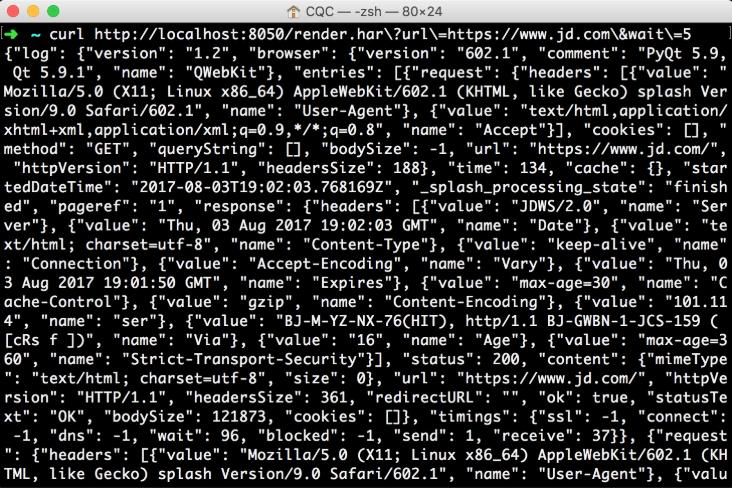
图7-18 运行结果
render.json
此接口包含了前面接口的所有功能,返回结果是JSON格式,示例如下:
curl http://localhost:8050/render.json?url=https://httpbin.org结果如下:
{"title": "httpbin(1): HTTP Client Testing Service", "url": "https://httpbin.org/", "requestedUrl": "https: //httpbin.org/", "geometry": [0, 0, 1024, 768]}可以看到,这里以JSON形式返回了相应的请求数据。
我们可以通过传入不同参数控制其返回结果。比如,传入html=1,返回结果即会增加源代码数据;传入png=1,返回结果即会增加页面PNG截图数据;传入har=1,则会获得页面HAR数据。例如:
curl http://localhost:8050/render.json?url=https://httpbin.org&html=1&har=1这样返回的JSON结果会包含网页源代码和HAR数据。
此外还有更多参数设置,具体可以参考官方文档:https://splash.readthedocs.io/en/stable/api.html#render-json。
execute
此接口才是最为强大的接口。前面说了很多Splash Lua脚本的操作,用此接口便可实现与Lua脚本的对接。
前面的render.html和render.png等接口对于一般的JavaScript渲染页面是足够了,但是如果要实现一些交互操作的话,它们还是无能为力,这里就需要使用execute接口了。
我们先实现一个最简单的脚本,直接返回数据:
function main(splash) return 'hello' end然后将此脚本转化为URL编码后的字符串,拼接到execute接口后面,示例如下:
curl http://localhost:8050/execute?lua_source=function+main%28splash%29%0D%0A++return+%27hello%27%0D%0Aend运行结果如下:
hello这里我们通过lua_source参数传递了转码后的Lua脚本,通过execute接口获取了最终脚本的执行结果。
这里我们更加关心的肯定是如何用Python来实现,上例用Python实现的话,代码如下:
import requests from urllib.parse import quote lua = ''' function main(splash) return 'hello' end ''' url = 'http://localhost:8050/execute?lua_source=' + quote(lua) response = requests.get(url) print(response.text)运行结果如下:
hello这里我们用Python中的三引号将Lua脚本包括起来,然后用urllib.parse模块里的quote()方法将脚本进行URL转码,随后构造了Splash请求URL,将其作为lua_source参数传递,这样运行结果就会显示Lua脚本执行后的结果。
我们再通过实例看一下:
import requests from urllib.parse import quote lua = ''' function main(splash, args) local treat = require("treat") local response = splash:http_get("http://httpbin.org/get") return { html=treat.as_string(response.body), url=response.url, status=response.status } end ''' url = 'http://localhost:8050/execute?lua_source=' + quote(lua) response = requests.get(url) print(response.text)运行结果如下:
{"url": "http://httpbin.org/get", "status": 200, "html": "{\n \"args\": {}, \n \"headers\": {\n \"Accept-Encoding\": \"gzip, deflate\", \n \"Accept-Language\": \"en,*\", \n \"Connection\": \"close\", \n \"Host\": \"httpbin.org\", \n \"User-Agent\": \"Mozilla/5.0 (X11; Linux x86_64) AppleWebKit/602.1 (KHTML, like Gecko) splash Version/9.0 Safari/602.1\"\n }, \n \"origin\": \"60.207.237.85\", \n \"url\": \"http://httpbin.org/get\"\n}\n"}可以看到,返回结果是JSON形式,我们成功获取了请求的URL、状态码和网页源代码。
如此一来,我们之前所说的Lua脚本均可以用此方式与Python进行对接,所有网页的动态渲染、模拟点击、表单提交、页面滑动、延时等待后的一些结果均可以自由控制,获取页面源码和截图也都不在话下。
到现在为止,我们可以用Python和Splash实现JavaScript渲染的页面的抓取了。除了Selenium,本节所说的Splash同样可以做到非常强大的渲染功能,同时它也不需要浏览器即可渲染,使用非常方便。
到此这篇关于Python3爬虫中Splash的知识总结的文章就介绍到这了,更多相关Python3中Splash的基础知识内容请搜索python博客以前的文章或继续浏览下面的相关文章希望大家以后多多支持python博客!
- << 上一篇 下一篇 >>
Python3爬虫中Splash的知识总结
看: 1131次 时间:2020-08-28 分类 : python爬虫
- 相关文章
- 2021-07-20Python爬虫基础之爬虫的分类知识总结
- 2021-07-20Python爬虫基础讲解之请求
- 2021-07-20PyQt5爬取12306车票信息程序的实现
- 2021-07-20Python爬虫之m3u8文件里提取小视频的正确姿势
- 2021-07-20如何用python抓取B站数据
- 2021-07-20快速搭建python爬虫管理平台
- 2021-07-20Python爬虫之获取心知天气API实时天气数据并弹窗提醒
- 2021-07-20Python爬虫之批量下载喜马拉雅音频
- 2021-07-20python使用pywinauto驱动微信客户端实现公众号爬虫
- 2021-07-20Requests什么的通通爬不了的Python超强反爬虫方案!
-
搜索
-
-
推荐资源
-
Powered By python教程网 鲁ICP备18013710号
python博客 - 小白学python最友好的网站!